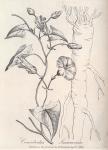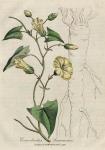
 Synonyma. Convolvulus, foliis sagittatis, postice truncatis, pedunculis bifloris. Roy Lugdb. 427.
Synonyma. Convolvulus, foliis sagittatis, postice truncatis, pedunculis bifloris. Roy Lugdb. 427.
Convolvulus Syriacus. Morris Hist. 2. p. 12.
Scammonium Syriacum. Gerard, 866. Lobel Icon, 620.
Gummi-Resina. Scammonium. Pharm. Lond. & Edin.
(greek) Diosc. (greek) Trallian et quorund. Graecor.
Class Pentandria. Ord. Monogynia. L. Gen. Plant. 215.
Ess. Gen. Ch. Cor. Campanulata, plicata. Stigmata 2. Caps. 2-locularis: loculis dispermis.
Spec. Char. C. fol. sagittatis postice truncatis, pedunc. teretibus subtrifloris.
This plant grows plentifully about Maraash, Antioch, Edlib, and towards Tripoly in Syria: it was first cultivated in England by Mr. Gerard, in 1597. The root is from three to four feet long, and from nine to twelve inches in circumference, covered with bark of a light grey colour, it is perennial, tapering, branched towards the bottom, and contains a milky juice; the stalks are numerous, slender, twining, and spread themselves upon the ground, or neighbouring trees, to the extent of fifteen or twenty feet; the leaves are arrow-shaped, smooth, of a bright green colour, and stand upon long footstalks: the flowers are funnel-shaped, yellowish, plicated, and, according to Dr. Ruffel, placed in pairs upon the pedicles: the calyx is double, consisting of four emarginated leaflets in each row: the capsule is three and sometimes four locular, [The Caps 2-locularis of Linnaeus, ought to be corrected.] containing seeds of a pyramidical shape. No part of the dried plant possesses any medicinal quality but the root, which Dr. Ruffel administered in decoction, and found it to be a pleasant and mild cathartic.
It is from the milky juice of the root that we obtain the officinal Scammony, which is procured in the following manner by the peasants, who collect it in the beginning of June: "[Dr. Ruffel's Description of this plant in the Medical Observations and Inquiries, v. 1. p. 18.] Having cleared away the earth from about the root, they cut off the top, in an oblique direction, about two inches below where the stalks spring from it. Under the most depending part of the slope they fix a shell, or some other convenient receptacle, into which the milky juice gradually flows. It is left there about twelve hours, which time is sufficient for draining off the whole juice: this, however, is in small quantity, each root affording but a very few drams. This juice from the several roots is put together, often into the leg of an old boot, for want of some more proper vessel, where in a little time it grows hard, and is the genuine Scammony."
This concrete is a gummy-resin, generally of a light, shining, grey colour, and friable texture. It is brought from Aleppo and Smyrna; [Some make it their business to go to the places where the Scammony is collected, and there buying it while yet soft, have an opportunity of mixing it with such things as best answers their purpose; as wheat-flower, ashes, fine sand, with all of which Dr. Ruffel found it adulterated. The purest Scammony is therefore the most active and most soluble.] that which comes from the latter place is less valued than the former, and is supposed to be more ponderous and of a deeper colour; but the colour affords no test of the goodness of this drug, which seems to depend entirely upon the purity of the concrete. The smell of Scammony is rather unpleasant, and the taste bitterish and slightly acrid. The different proportions of gum and resin of which it consists, have been variously stated, [Boulduc Mem. de l'Ac. de Sc. 1702. Geoffrey Mat. Med.] but as proof spirit is the best menstruum for it, these substances are supposed to be nearly in equal parts.
Scammony appears to have been well known to the Greek and Arabian physicians, [Hippocrates, Dioscorides, Aëtius, Mesue, &c.] and was not only employed internally as a purgative, but also as an external remedy for tumours, scabies, tinea, fixed pains, &c.—Although this drug was seldom given alone, yet we find it was very generally used, [As Diagrydium. Scam defoecatum per succum citroniorum. Extractum spt vin. Extract. diagridii aromaticum. Extract, scam. glycyrrhizatum. Elixir Scammon. Scam. vitriolatum, Scam. sulphuratum, Scam. rosatum, Infusum scammonii, Diacydonium lucidum scammoniatum. Gelatina cydoniorum laxativa, &c.] and an ingredient in many [Among these were the Pulvis de Tribus, or Pulvis trium Diabolorum, Pulvis Basilicus, Pulvis Comitis de Warwick, which was afterwards called Pulvis Cornachini, because Marcus Cornachini, professor of medicine at Pisa, recommended it as a panacea, in a book, the title of which is, "Methodus qua omnes humani corporis affectiones ab humoribus copiâ aut qualitae peccantibus genitae, tuto, cito, et jucunde curantur."] compounds which were formerly held in very great repute.—Hoffman, however, entertained an opinion, that Scammony was a dangerous medicine; "Ego nunquam in praxi mea in usu habui, nec in posterum habebo; me semper ab istiusmodi venenis colliquativis abstinens. Hoff. in Schrod. p. 543." But since Boerhaave's time it has been considered as a safe though stimulating cathartic, and frequently prescribed uncombined with any other substance, yet neither producing tormina nor hypercatharsis. Like other resinous purgatives it is uncertain in its operation, which may be occasioned by the interlines being more or less defended from the action of these stimulants, by the quantity of natural mucus with which they are covered.
The dose of Scammony is generally from three to twelve grains. It is commonly triturated with sugar, almonds, &c. or with a decoction of liquorice, as recommended by the college of Wirtemberg. In the London Pharmacopoeia it is ordered in the following compounds:—Pulvis e scammonio compositus. Pulvis e scammonio compositus cum aloe. Pulvis e scammonio cum calomelane. Pulvis e senna compositus. Extractum colocynthidis compositum. And in the Pilulae ex colocynthide cum aloe of the Edinburgh Pharm.

